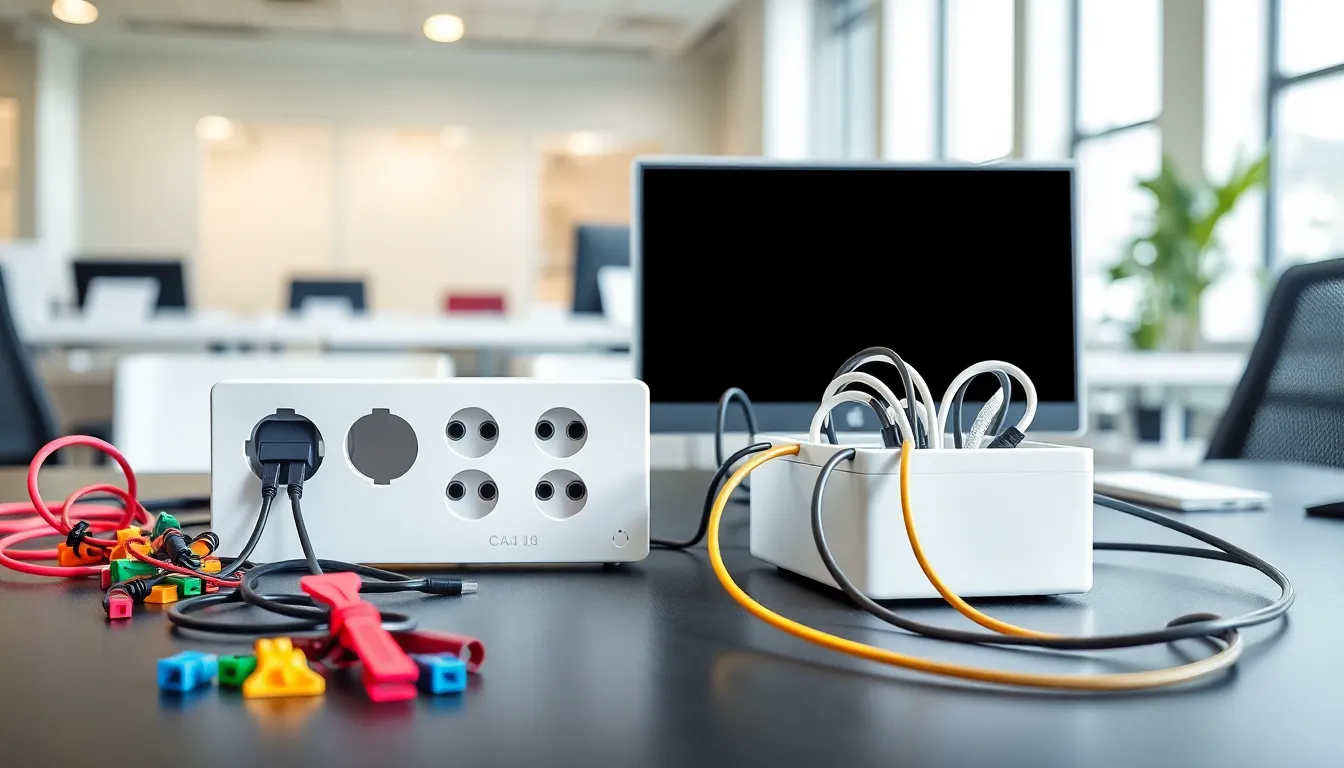Tangled cables are like that one sock that mysteriously disappears in the laundry—frustrating and entirely avoidable. In a world where technology rules, managing those unruly cords is crucial for maintaining a clean and efficient workspace. Not only does proper cable management make your setup look sleek, but it also saves time and sanity when you need to find that elusive charger or HDMI cable.
Imagine walking into an office where cables are neatly tucked away instead of resembling a chaotic spaghetti dinner. It’s not just about aesthetics; good cable management reduces hazards and prolongs the life of your electronics. So, whether you’re a tech enthusiast or just someone trying to avoid a tripping hazard, mastering the art of cable management is a game changer. Let’s dive into the world of cables and discover how to transform your tangled mess into a masterpiece of organization.
Table of Contents
ToggleImportance Of Cable Management
Effective cable management plays a crucial role in maintaining an organized, efficient workspace. Tangled cables not only create a visual distraction but can also lead to serious safety issues.
Benefits Of Cable Management
Effective cable organization offers numerous advantages. First, it enhances the appearance of a workspace, promoting a more professional atmosphere. Second, better organization increases efficiency by minimizing time spent searching for the right cable. Third, it reduces the risk of accidents caused by tripping over loose cords. Fourth, proper cable management can prolong the lifespan of electronic devices by improving air circulation and reducing wear caused by tangling. Lastly, it encourages better maintenance routines, allowing for easy access during troubleshooting.
Common Issues Without Proper Management
Neglecting cable management results in several complications. First, tangled cords often lead to confusion, making it difficult to identify connections. Second, without organization, cables may become damaged due to unnecessary strain and friction. Third, safety hazards increase as loose cables can create tripping risks. Fourth, cluttered workspaces can adversely affect productivity by creating a distracting environment. Lastly, poor cable management may impede airflow around devices, leading to overheating and potential damage.
Types Of Cable Management Solutions

Numerous solutions exist for effective cable management, each serving specific needs for organization and safety.
Cable Ties And Clips
Cable ties and clips provide a simple solution for securing cords together. They come in various materials, such as nylon, Velcro, and rubber, catering to different requirements. Many users choose reusable Velcro ties to allow adjustments as needed. Clips attach to surfaces, providing a stable and organized pathway for cords. These solutions are both affordable and easy to implement, making them popular choices for maintaining clean workspaces.
Cable Management Boxes
Cable management boxes conceal loose cables, enhancing aesthetics while reducing clutter. Typically made from plastic or wood, these boxes blend seamlessly into various environments. They often feature multiple openings for cable entry, allowing for flexibility in organizing cords. Many models include ventilation holes to facilitate airflow, helping prevent overheating of devices. Using these boxes can lead to a significant improvement in overall workspace tidiness and safety.
Tips For Effective Cable Management
Effective cable management transforms chaotic spaces into organized environments. Following a few key strategies enhances efficiency and safety.
Organizing Cables By Type
Grouping cables by type streamlines setups significantly. For example, keep power cables, data cables, and audio/video cables separate. Avoid confusion by storing similar cables together in designated areas. Utilize cable ties or clips to secure groups, preventing tangling. Coordinating cables this way eases future modifications or troubleshooting. Color-coded ties can add an extra layer of organization while improving visibility.
Labeling Cables For Easy Identification
Labeling cables saves time and frustration. Use labels on both ends of each cable for clear identification. Consider durable, waterproof labels to withstand wear. Consistent labeling practices allow quick connections and disconnections, especially in multi-device setups. A simple numbering or color-coding system enhances the readability of labels. By implementing this strategy, anyone can quickly pinpoint the right cable without unnecessary searching.
Tools And Accessories For Cable Management
Effective cable management tools and accessories enhance organization, safety, and aesthetics in any workspace.
Cable Management Sleeves
Cable management sleeves offer a streamlined way to bundle multiple cords together. These flexible covers protect cables from damage and tangling. Available in various sizes and colors, they accommodate different applications, enhancing personalization options. By using sleeves, users can maintain a tidy appearance and reduce visual clutter. Additionally, some sleeves feature zippers or velcro for easy access to cables. Many choose a sleeve to group cables by function, creating distinct sections for power cords and data cables.
Under-Desk Cable Organizers
Under-desk cable organizers keep cords out of sight while maximizing floor space. These accessories often attach securely to desk surfaces, organizing cables efficiently beneath workspace areas. Options include cable trays and adhesive clips, accommodating specific needs and desk designs. By utilizing these organizers, individuals prevent cables from tangling and minimize hazards. Easy access remains crucial, allowing users to manage cables effortlessly without disrupting their setup. A clutter-free environment not only enhances productivity but also contributes to overall safety.
Effective cable management is essential for creating a safe and organized workspace. By implementing the right strategies and tools, individuals can eliminate the chaos of tangled cords and enhance their productivity. The benefits extend beyond aesthetics; they include improved safety and device longevity.
Investing time in organizing cables pays off with a more efficient environment that promotes focus and minimizes hazards. Whether it’s using cable ties, management boxes, or sleeves, each solution contributes to a cleaner setup. Adopting these practices not only simplifies daily tasks but also fosters a professional atmosphere that reflects attention to detail. Embracing cable management is a step toward a more functional and visually appealing workspace.



